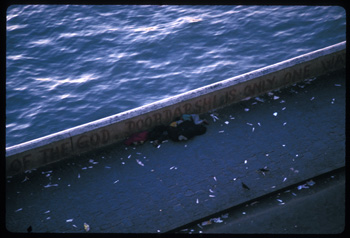When two countries with the means and the mutual animosity to nuke the daylights out of one another and mess up the world are sitting down to see if they can make peace a cautious hope ensues. Yesterday political leaders Pakistani President Musharraf and Indian Prime Minister Vajaypee shook hands and are attempting a reconciliation that might get over the wounds of three wars and nearly a nuclear encounter in 2002. India and Pakistan have been at it with each other since the Brits precipitously bailed out of their jewel of the imperial at midnight on August 15, 1947. Their mutual slaughter on that occasion has only been on hold since then, with disputed hegemony over Kashmir as a political flashpoint, and, the ubiquitous Hindu-Muslim antipathies reaching down to the very marrow of Indian civil society.
It is one of the paradoxes of nations that the difference that give them a rich cultural stew are often the very features that often threaten societal annihilation. So it seems with India, an enduringly fascinating and frustrating country I have had the opportunity to visit on two occasions. The first time, in 1992, could have been the last visit there, or anywhere, when my dear friend Sue and I found ourselves in the middle of what I called . . .
The Bombay Land Use Jihad
The last thing I would have thought as the huge sewer pipes rolled ominously toward my taxi was that I might be done in by a land use. After all, this was Bombay, and the land use at issue was nearly a thousand kilometers away in Ayodhya.
But this was India, and the land use was a mosque, one reputedly built on the site of the birthplace of the Hindu god Rama in 1,500 B.C. Never mind that the mosque was built only thirty years after Columbus discovered America. Like I said, this was India, and disputes go back a long way in these parts. And so do the antipathies over which god or goddess is the rightful resident of a piece of holy ground. The current controversy was precipitated when 4,000 Hindu “kar sevaks” pulled the Babri Mosque down with their bare hands yesterday, and now there were aftershocks all over India.

Streetsleepers of Bombay
© James A. Clapp
Fires were already burning in several parts of Bombay, in one of the areas of “chawls,” where tens of thousands inhabit these ancient and rickety tenements at incredible densities, and in the teeming shanty-colonies that through squinted-eyes and pinched-nostrils, are indistinguishable, visually, olfactorily, and, socially, from (un)sanitary land-fills.
People were already dead, slain as much by religious bigotry and hatred as by the knives that are the preferred implement of dispatching their victims to Allah or to another round of Hindu reincarnation. Casualties of a holy land use war.
“Go for it!” I encouraged the driver, who seemed to be considering abandoning his taxi and fare as hundreds of others already had. So he weaved between and around the huge sewer pipes that could have crushed the taxi like a Pepsi can. The irony of it all wasn’t lost on me: in a city that sorely needs some sewerage they use the pipes to block streets and conduct murderous riots.
That wasn’t all. Here we were on my way back from a visit to Gandhi’s house, the pacifist who had several times threatened to starve himself to death to arrest the Hindu-Muslim carnage that took more than a million lives after the British partitioned the sub-continent into India and two Pakistans (major land use dispute) in 1947. And one of the dioramas at Gandhi’s house showed him being assassinated by a Hindu fanatic who belonged to the Hindu extremist faction that is precursor to the current kar sevaks. Not to mention that me, a lapsed-Catholic, had a good chance of being killed in an officially secular state in a war between two religions. Would it be preferable to have my throat slit by a mob of Muslims, or Hindus? Better not at all.
“Keep going!” I ordered the driver.
In the previous days’ wanderings about this exotic and swollen city it had seemed there was little left to be disputed in the use of its land. In reflection of its social castes, the architecture and land use of Bombay co-exist and juxtapose in astonishing variance. Below our window in the renowned Taj Mahal Hotel reposed hundreds whose beds consisted of littered and feculent sidewalks. Here, and along most of the streets of this bustling metropolis, untold numbers live, eat, copulate, sleep, beg, and die, alfresco.
The Taj Hotel, like the Victoria Terminus train station, and the University of Bombay radiate the Gothic splendors of the departed British Raj, cheek by jowl with deity-festooned Hindu temples, and pitiable enterprises countless street vendors. On the west side of town splashy high-rise modern hotels garland the magnificent corniche of Chowpatty Beach, interspersed with derelict buildings and homeless. Soul-searing poverty and hopelessness taint every land use in Bombay. There is nothing, and everything, to fight and die for.
Our taxi pulled into the relative safety of the port the Bombay. The death toll had reached seventy. Only as our ship glided past the Gateway Arch of India did it occur to me that, for so many here there is probably little more to hope for than a better afterlife. It seems like the only hope left in a country that makes jihad over where their gods can reside.
___________________________________
©1993, ©2004, James A. Clapp (UrbisMedia Ltd. Pub. 1.7.2004)
Originally published in the San Diego American Planning Association Journal, March, 1993
